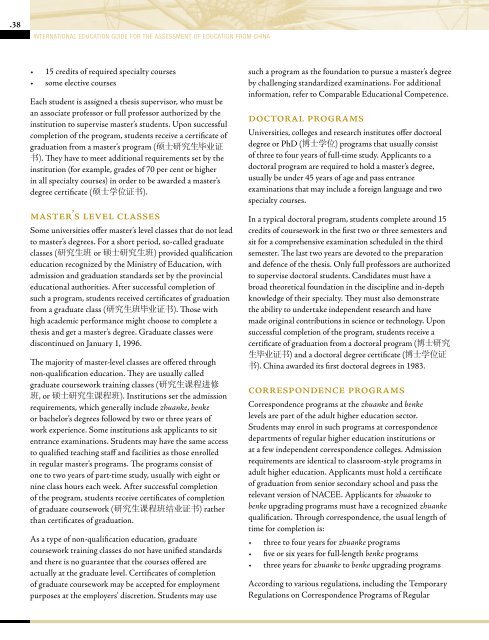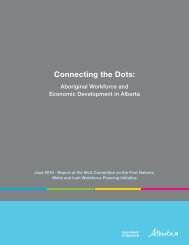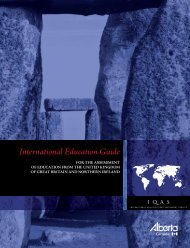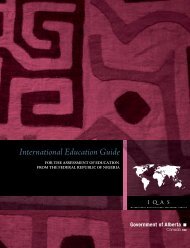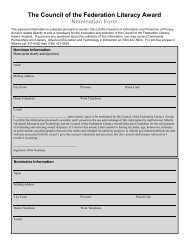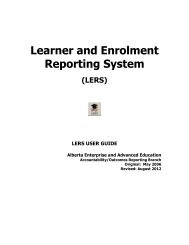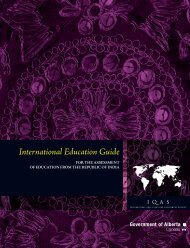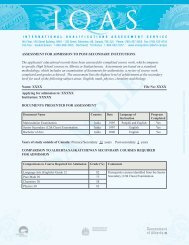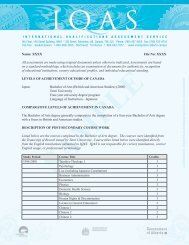International Education Guide - China - Enterprise and Advanced ...
International Education Guide - China - Enterprise and Advanced ...
International Education Guide - China - Enterprise and Advanced ...
Create successful ePaper yourself
Turn your PDF publications into a flip-book with our unique Google optimized e-Paper software.
.38<br />
INTERNATIONAL EDUCATION GUIDE FOR THE ASSESSMENT OF EDUCATION FROM CHINA<br />
• 15 credits of required specialty courses<br />
• some elective courses<br />
Each student is assigned a thesis supervisor, who must be<br />
an associate professor or full professor authorized by the<br />
institution to supervise master’s students. Upon successful<br />
completion of the program, students receive a certificate of<br />
graduation from a master’s program ( 硕 士 研 究 生 毕 业 证<br />
书 ). They have to meet additional requirements set by the<br />
institution (for example, grades of 70 per cent or higher<br />
in all specialty courses) in order to be awarded a master’s<br />
degree certificate ( 硕 士 学 位 证 书 ).<br />
master’s level classes<br />
Some universities offer master’s level classes that do not lead<br />
to master’s degrees. For a short period, so-called graduate<br />
classes ( 研 究 生 班 or 硕 士 研 究 生 班 ) provided qualification<br />
education recognized by the Ministry of <strong>Education</strong>, with<br />
admission <strong>and</strong> graduation st<strong>and</strong>ards set by the provincial<br />
educational authorities. After successful completion of<br />
such a program, students received certificates of graduation<br />
from a graduate class ( 研 究 生 班 毕 业 证 书 ). Those with<br />
high academic performance might choose to complete a<br />
thesis <strong>and</strong> get a master’s degree. Graduate classes were<br />
discontinued on January 1, 1996.<br />
The majority of master-level classes are offered through<br />
non-qualification education. They are usually called<br />
graduate coursework training classes ( 研 究 生 课 程 进 修<br />
班 , or 硕 士 研 究 生 课 程 班 ). Institutions set the admission<br />
requirements, which generally include zhuanke, benke<br />
or bachelor’s degrees followed by two or three years of<br />
work experience. Some institutions ask applicants to sit<br />
entrance examinations. Students may have the same access<br />
to qualified teaching staff <strong>and</strong> facilities as those enrolled<br />
in regular master’s programs. The programs consist of<br />
one to two years of part-time study, usually with eight or<br />
nine class hours each week. After successful completion<br />
of the program, students receive certificates of completion<br />
of graduate coursework ( 研 究 生 课 程 班 结 业 证 书 ) rather<br />
than certificates of graduation.<br />
As a type of non-qualification education, graduate<br />
coursework training classes do not have unified st<strong>and</strong>ards<br />
<strong>and</strong> there is no guarantee that the courses offered are<br />
actually at the graduate level. Certificates of completion<br />
of graduate coursework may be accepted for employment<br />
purposes at the employers’ discretion. Students may use<br />
such a program as the foundation to pursue a master’s degree<br />
by challenging st<strong>and</strong>ardized examinations. For additional<br />
information, refer to Comparable <strong>Education</strong>al Competence.<br />
doctoral programs<br />
Universities, colleges <strong>and</strong> research institutes offer doctoral<br />
degree or PhD ( 博 士 学 位 ) programs that usually consist<br />
of three to four years of full-time study. Applicants to a<br />
doctoral program are required to hold a master’s degree,<br />
usually be under 45 years of age <strong>and</strong> pass entrance<br />
examinations that may include a foreign language <strong>and</strong> two<br />
specialty courses.<br />
In a typical doctoral program, students complete around 15<br />
credits of coursework in the first two or three semesters <strong>and</strong><br />
sit for a comprehensive examination scheduled in the third<br />
semester. The last two years are devoted to the preparation<br />
<strong>and</strong> defence of the thesis. Only full professors are authorized<br />
to supervise doctoral students. C<strong>and</strong>idates must have a<br />
broad theoretical foundation in the discipline <strong>and</strong> in-depth<br />
knowledge of their specialty. They must also demonstrate<br />
the ability to undertake independent research <strong>and</strong> have<br />
made original contributions in science or technology. Upon<br />
successful completion of the program, students receive a<br />
certificate of graduation from a doctoral program ( 博 士 研 究<br />
生 毕 业 证 书 ) <strong>and</strong> a doctoral degree certificate ( 博 士 学 位 证<br />
书 ). <strong>China</strong> awarded its first doctoral degrees in 1983.<br />
correspondence programs<br />
Correspondence programs at the zhuanke <strong>and</strong> benke<br />
levels are part of the adult higher education sector.<br />
Students may enrol in such programs at correspondence<br />
departments of regular higher education institutions or<br />
at a few independent correspondence colleges. Admission<br />
requirements are identical to classroom-style programs in<br />
adult higher education. Applicants must hold a certificate<br />
of graduation from senior secondary school <strong>and</strong> pass the<br />
relevant version of NACEE. Applicants for zhuanke to<br />
benke upgrading programs must have a recognized zhuanke<br />
qualification. Through correspondence, the usual length of<br />
time for completion is:<br />
• three to four years for zhuanke programs<br />
• five or six years for full-length benke programs<br />
• three years for zhuanke to benke upgrading programs<br />
According to various regulations, including the Temporary<br />
Regulations on Correspondence Programs of Regular


